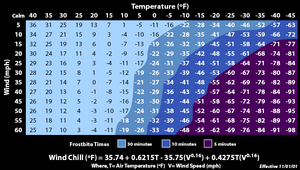Wind chill facts for kids

Wind chill is a way to describe how cold it *feels* outside when the wind is blowing. It's not the actual temperature shown on a thermometer, but rather what your body experiences. Imagine a cold day with no wind; it might feel chilly. Now imagine the same temperature, but with a strong wind. That wind makes it feel much colder, right? That's wind chill! It's important to know about wind chill because it helps us understand how quickly we can get too cold and how to stay safe.
Wind chill numbers are always lower than the actual outside temperature. When the temperature felt outside is higher than the real temperature, the heat index is used instead.
Contents
What is Wind Chill?
Wind chill happens because wind takes heat away from your body faster. Your body naturally creates a thin layer of warm air around your skin. This layer helps keep you warm. When the wind blows, it sweeps away this warm air, making you feel colder. It's like standing in front of a fan when you're sweaty – the air moving over your skin makes you feel cooler because it helps sweat evaporate and takes heat away.
The colder the air and the stronger the wind, the faster your body loses heat. This is why a temperature of 0 degrees Celsius (32 degrees Fahrenheit) with strong wind can feel much colder than 0 degrees Celsius with no wind.
How is Wind Chill Measured?
Scientists and weather experts use a special formula to calculate wind chill. This formula considers two main things:
- The actual air temperature.
- The speed of the wind.
The result of this calculation is the "feels like" temperature. For example, if the air temperature is -10 degrees Celsius (14 degrees Fahrenheit) and the wind is blowing at 30 kilometers per hour (18 miles per hour), it might *feel* like -20 degrees Celsius (-4 degrees Fahrenheit) to your body. This "feels like" number is the wind chill.
Weather forecasts often include the wind chill so people know how to dress properly for the conditions.
Why is Wind Chill Important?
Understanding wind chill is very important for staying safe in cold weather. When the wind chill is low, your body can lose heat very quickly. This increases the risk of two serious cold-related problems:
- Frostbite: This happens when parts of your body, like your fingers, toes, nose, or ears, freeze. The skin and tissues can get damaged.
- Hypothermia: This is when your body loses heat faster than it can produce it, causing your body temperature to drop dangerously low. It can be very serious and even life-threatening.
Knowing the wind chill helps you decide what kind of clothes to wear. On a day with a low wind chill, you'll need warmer clothes, like layers, a warm hat, gloves, and a scarf, to protect exposed skin.
Protecting Yourself from Wind Chill
When the wind chill is low, here are some tips to stay warm and safe:
- Dress in layers: Wearing several thin layers of clothing is better than one thick layer. Air trapped between the layers helps insulate you.
- Cover exposed skin: Wear a warm hat, gloves or mittens, and a scarf or neck gaiter to protect your head, ears, hands, and face.
- Stay dry: Wet clothes lose their insulating power quickly. If your clothes get wet, change into dry ones as soon as possible.
- Limit time outdoors: On very cold and windy days, try to stay inside as much as you can.
- Stay hydrated and eat well: Your body needs energy to stay warm.
Related pages
Images for kids
See also
 In Spanish: Temperatura de sensación para niños
In Spanish: Temperatura de sensación para niños


